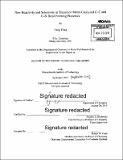| dc.contributor.author | Yang, Yang, Ph. D. Massachusetts Institute of Technology | en_US |
| dc.contributor.other | Massachusetts Institute of Technology. Department of Chemistry. | en_US |
| dc.date.accessioned | 2016-03-03T21:08:53Z | |
| dc.date.available | 2016-03-03T21:08:53Z | |
| dc.date.copyright | 2015 | en_US |
| dc.date.issued | 2015 | en_US |
| dc.identifier.uri | http://hdl.handle.net/1721.1/101558 | |
| dc.description | Thesis: Ph. D. in Organic Chemistry, Massachusetts Institute of Technology, Department of Chemistry, 2015. | en_US |
| dc.description | Cataloged from PDF version of thesis. Volume 1 (page 1 to page 510) ; Volume 2 (page 511 to 881). Duplicated pages for pages 195 to 240 are bound after page 881. | en_US |
| dc.description | Includes bibliographical references. | en_US |
| dc.description.abstract | Part I. Palladium-Catalyzed Carbon-Carbon Bond Forming Cross-Couplings Chapter 1. Ligand-Controlled Palladium-Catalyzed Regiodivergent Suzuki-Miyaura Cross-Coupling of Allylboronates and Aryl Halides An orthogonal set of catalyst systems based on the use of two biarylphosphine ligands has been developed for the Suzuki-Miyaura coupling of 3,3-disubstituted and 3-monosubstituted allylboronates with (hetero)aryl halides. These methods allow for the regiodivergent preparation of either the ct- or the [gamma]-isomeric coupling product with high levels of site selectivity using a common allylboron building block. Preliminary investigations have demonstrated the feasibility of an enantioselective variant for the [gamma]-selective cross-coupling using chiral monodentate biarylphosphine ligands. Chapter 2. Palladium-Catalyzed Completely Linear-Selective Negishi Coupling of 3,3-Disubstituted Organozinc Reagents with Aryl and Vinyl Electrophiles A palladium-catalyzed general and completely linear-selective Negishi coupling of 3,3- disubstituted allyl organozinc reagents with (hetero)aryl and vinyl electrophiles has been developed. This method provided an effective means for accessing highly functionalized aromatic and heteroaromatic compounds bearing prenyl-type side chains. The utility of the current protocol was further illustrated in the concise synthesis of the anti-HIV natural product siamenol. Chapter 3. Palladium-Catalyzed Highly Selective Negishi Cross-Coupling of Secondary Alkylzinc Reagents with Aryl and Heteroaryl Halides The palladium-catalyzed Negishi cross-coupling of secondary alkylzinc reagents and heteroaryl halides with high levels of regioisomeric retention has been described. The development of a series of biarylphosphine ligands has led to the identification of an improved catalyst for the coupling of electron-deficient heterocyclic substrates. Preparation and characterization of oxidative addition complex (L)Pd(Ar)(Br) provided insight into the unique reactivity of palladium catalysts based on CPhos-type biarylphosphine ligands in facilitating challenging reductive elimination processes. Chapter 4. Mechanistic Studies on the Aryl-Trifluoromethyl Reductive Elimination from Pd(II) Complexes Based on Biarylphosphine Ligands A series of monoligated (L)Pd(Ar)(CF₃) (L = dialkyl biarylphosphine) have been prepared and studied in an effort to shed light on the mechanism of the aryl-trifluoromethyl reductive elimination from these systems. Combined experimental and computational investigations revealed unique reactivity and binding modes of (L)Pd(Ar)(CF₃) complexes derived from BrettPhos-type biarylphosphines. In contrast to a variety of C-C and C-heteroatom bond forming reductive eliminations, kinetic measurements showed this Ar-CF₃ reductive elimination is largely insensitive to the electronic nature of the to-be-eliminated aryl substituent. Furthermore, the aryl group serves as the nucleophilic coupling partner in this reductive elimination process. The structure-reactivity relationship of biarylphosphine ligands was also investigated, uncovering distinct roles of the ipso-arene and alkoxy interactions in affecting these reductive elimination reactions. Part II. Copper-Catalyzed Carbon-Carbon and Carbon-Nitrogen Bond Formation via Olefin Functionalization Chapter 5. Copper-Catalyzed ortho C-H Cyanation of Vinylarenes A copper-catalyzed regioselective ortho C-H cyanation of vinylarenes has been developed. This method provides an effective means for the selective functionalization of vinylarene derivatives. A copper-catalyzed cyanative dearomatization mechanism is proposed to account for the regiochemical course of this reaction. This mechanism has been validated through density functional theory calculations. Computational studies revealed that the high level of ortho selectivity in the electrophilic cyanation event originates from a unique six-membered transition state that minimizes unfavorable steric repulsions. Chapter 6. Regio- and Stereospecific 1,3-Allyl Group Transfer Triggered by a Copper-Catalyzed Borylation/ortho-Cyanation Cascade A copper-catalyzed borylation/cyanation/allyl group transfer cascade has been developed. This process features an unconventional copper-catalyzed electrophilic dearomatization followed by the subsequent regio- and stereospecific 1,3-transposition of the allyl fragment enabled by the aromatization-driven Cope rearrangement. This method provides an effective means for the construction of adjacent tertiary and quaternary stereocenters with high levels of stereochemical purity. Chapter 7. Copper-Catalyzed Asymmetric Hydroamination of Unactivated Internal Olefins: an Effective Means to Access Highly Enantioenriched Aliphatic Amines Catalytic assembly of enantiopure aliphatic amines from abundant and readily available precursors has long been recognized as a paramount challenge in synthetic chemistry. We describe a mild and general copper-catalyzed hydroamination that effectively converts unactivated internal olefins-an important yet unexploited class of abundant feedstock chemicals-into highly enantioenriched [alpha]-branched amines (>/= 96% ee) featuring two minimally differentiated aliphatic substituents. This method provides a powerful means to access a broad range of advanced, highly functionalized enantioenriched amines of interest in pharmaceutical research and other areas. | en_US |
| dc.description.statementofresponsibility | by Yang Yang. | en_US |
| dc.format.extent | 2 volumes (881 pages) | en_US |
| dc.language.iso | eng | en_US |
| dc.publisher | Massachusetts Institute of Technology | en_US |
| dc.rights | M.I.T. theses are protected by copyright. They may be viewed from this source for any purpose, but reproduction or distribution in any format is prohibited without written permission. See provided URL for inquiries about permission. | en_US |
| dc.rights.uri | http://dspace.mit.edu/handle/1721.1/7582 | en_US |
| dc.subject | Chemistry. | en_US |
| dc.title | New reactivity and selectivity in transition metal-catalyzed C-C and C-N bond forming processes | en_US |
| dc.type | Thesis | en_US |
| dc.description.degree | Ph. D. in Organic Chemistry | en_US |
| dc.contributor.department | Massachusetts Institute of Technology. Department of Chemistry | |
| dc.identifier.oclc | 940567203 | en_US |
